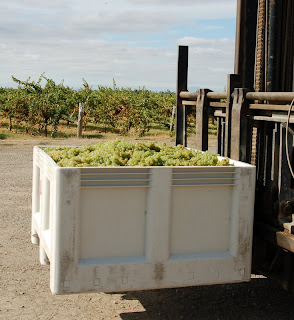
Autumn is indeed settling in and the few deciduous trees we have around
Napa are showing off brilliant hues of yellow, orange, and red. One star performer in this category that often fails to get attention is
Vitis californica, the native California wild grape. This deciduous vine is not shy and is very conspicuous, this time of year, in it's encroachment upon other vegetation. In riparian woodlands,
stream-banks, and
swales you can spot this wild vine scrambling up the trees and shrubs that are capable of supporting it's vertical growth habit of up to 40 feet.
V. californica is important to wildlife as it's vegetation provides shelter and it's grapes, which ripen quite late, provide autumn and winter food for
Napa's resident critters and our winter visitors.
The native vine has been employed in California since long before the first Spanish Padres planted their mission vineyards. Indigenous people cultivated and ate the grapes and leaves, used dried vines to weave baskets, and made tinctures to be used as mouthwashes and as a treatment for diarrhea. Lovely!
Apparently, jam can be also made from it's grapes. I have never personally seen a cluster of
V. californica grapes. I've only glimpsed these vines from afar, usually out of my car window, and have never really felt a pressing need to clamber through a thicket, and risk getting a bad case of poison oak in the process, just for a quick look-see. There are plenty of cultivated grape varietals here in
Vinoland to satiate any desire I may have to get up close and personal with a berry. Besides, who am I kidding, I much prefer having Thud and
Prince Charles take care of all my jammy aspirations.
 Two French, two domestic: This is the selection of bubbly for tonight's festivities. Only one candidate for merriment is a vintage sparkler, (it just so happens to be the locally produced 2000 DVX by Mumm Napa Valley), the others are non-vintage. 75% of the offerings are technically from the same producer, G.H. Mumm. 100% of the wines, thankfully, have the Chardonnay grape as the smallest component.
Two French, two domestic: This is the selection of bubbly for tonight's festivities. Only one candidate for merriment is a vintage sparkler, (it just so happens to be the locally produced 2000 DVX by Mumm Napa Valley), the others are non-vintage. 75% of the offerings are technically from the same producer, G.H. Mumm. 100% of the wines, thankfully, have the Chardonnay grape as the smallest component.


































.JPG)












